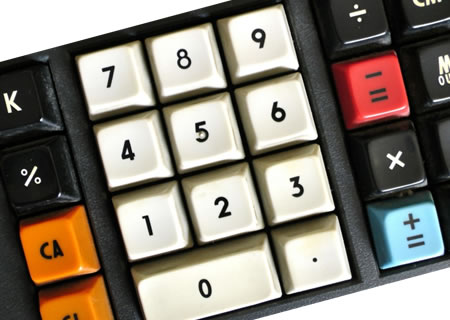Get tons of free content, like our Games to Play at Home packet, puzzles, lessons, and more!

Description
-
Author:
-
Posted:Fri, November 13, 2015, last modified December 5, 2019
-
Topics:
-
Grades:
-
Type:
-
Keywords:
Overview
Topics: Addition, Subtraction, Skip Counting, Multiplication, Logic
Materials: Scratch paper and pencil, handouts (optional)
Recommended Grade: 3, 4, 5, 6
Common Core: 3.OA.A.3, 3.OA.A.4, 3.OA.B.5, 3.OA.D.8, 3.OA.D.9, 4.OA.A.4, 4.OA.C.5, MP1, MP2, MP3, MP6, MP7, MP8
Something is wrong with the calculators in each lesson.
Can students reach the target number despite the broken buttons?
Why We Love Broken Calculators
The premise is simple, but Broken Calculators gets kids into rigorous mathematical thinking quickly and deeply. Great for skills practice and connecting addition to multiplication. This structure is also easy to adapt and differentiate, and is great for group work and mathematical conversations in the classroom.
We recommend using a “group contest” model for these problems, though other formats are possible as well.
Lesson 1: Broken Keys
The Launch (5-10 minutes)
Teacher: We’re going to play Broken Calculators today.
Each calculator has at least one broken key and a target number we’re trying to hit.
For example, let’s say my target number was 11, but the “1” key is broken.
How can I make 11 without using 1?
I can’t hit “1,1” since the “1” key doesn’t work.
My first thought is 10 + 1, but that doesn’t work. Anyone see why? [call on a student.]
So how could you do it?
Student 1: I would do 13 – 2.
Teacher: Anyone see a problem with that?
Student 2: Wait! That has a “1” in it! So we can’t do it.
Teacher: Maybe we can’t get to 11 after all.
Student: I see a way to do it. We could just do 9 + 2. (Other possible answers: 8 + 3, 33 – 22, etc]
Teacher: What does everyone think? Thumbs up? [Students give a thumbs up]
Teacher: All right. We’re going to go in several rounds today. I’m going to put three targets up for each calculator, and your group will try to hit all the targets. I’ll call on groups between rounds to get answers. You’ll have about 3 minutes per round.
The Work
The teacher poses all three numbers in each round at the same time, and gives the students 2-5 minutes to solve them all in as many ways as they can. Between each round, call on groups to confirm their answers. Points are optional.
Every group should have scratch paper and pencils.
Tips For The Classroom
- You can simply challenge students to solve the problems in groups, which will likely be motivation enough. You can also keep score by awarding groups points if they have an answer to the problem. You can also give points to the group that comes up with the most correct ways to get to an answer.
- You can lengthen the time allowed or change rules to support student engagement as necessary. You can also give three-digit numbers as challenges to groups or individuals who are solving the problem with ease.
Round 1
The calculator has a broken 1 key and a
broken 3 key.
Make the following numbers:
A. 13
B. 31
C. 33
Round 2
The calculator has a broken 2 key and a
broken 5 key.
Make the following numbers:
A. 22
B. 25
C. 52
Round 3
The calculator has a broken 1 key, and
broken 7 key, and a broken + key.
Make the following numbers:
A. 17
B. 41
C. 71
Round 4
The calculator has broken 1, 2, 3, 4, 5,
and 6 keys.
Make the following numbers:
A. 11
B. 12
C. 30
Lesson 2: Broken Calculators
The Launch (5 minutes)
Use the same structure as in Lesson 1. The only difference today is that the calculators are profoundly broken: instead of a few keys being broken, only a few keys are working.
The first calculator has a +3 button which adds 3 and a +7 button which adds 7.
With just those keys, ask the students how they could make 10 (+3, then +7, or vice versa) or 14 (+7 twice).
Once they understand the new calculator, break into groups and pose the following questions in rounds, as in part 1.
The Work
If time permits, you can ask all the same challenges again, except with a calculator that has only a +7 and -3 button.
The Wrap Up
As an exit ticket, ask a final challenges for each student to write down individually:
How can you make 50 with the +7, +3 Calculator?
How can you make 51?
NEW! Followup video from TED-Ed
For a more challenging followup, check out the Giant Cat Army Riddle from TED-Ed.
REMEMBER TO PAUSE THE VIDEO HALFWAY THROUGH!
 back to FreeLessons
back to FreeLessons